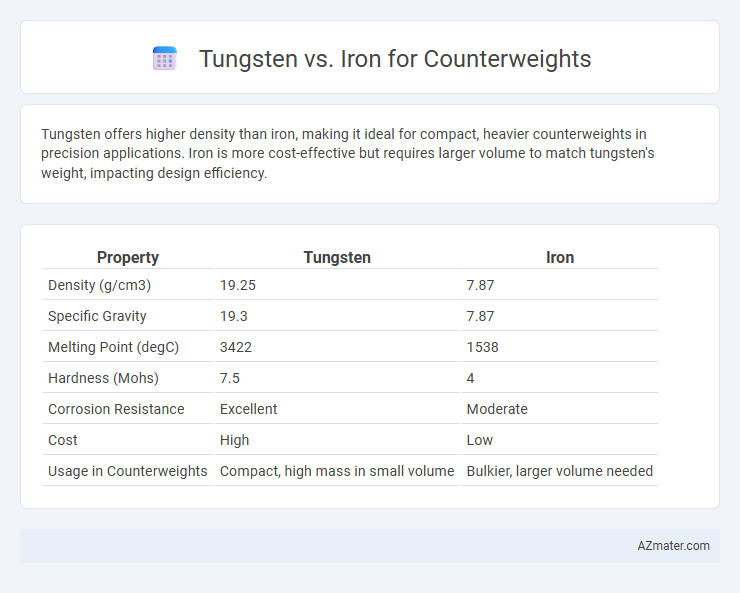Tungsten offers higher density than iron, making it ideal for compact, heavier counterweights in precision applications. Iron is more cost-effective but requires larger volume to match tungsten's weight, impacting design efficiency.
Table of Comparison
| Property | Tungsten | Iron |
|---|---|---|
| Density (g/cm3) | 19.25 | 7.87 |
| Specific Gravity | 19.3 | 7.87 |
| Melting Point (degC) | 3422 | 1538 |
| Hardness (Mohs) | 7.5 | 4 |
| Corrosion Resistance | Excellent | Moderate |
| Cost | High | Low |
| Usage in Counterweights | Compact, high mass in small volume | Bulkier, larger volume needed |
Introduction to Counterweight Materials
Counterweight materials are critical in balancing mechanisms for cranes, elevators, and machinery, where tungsten and iron are commonly used. Tungsten offers a higher density of approximately 19.3 g/cm3 compared to iron's 7.87 g/cm3, enabling smaller, more compact counterweights. The superior density and durability of tungsten make it preferable in applications requiring space efficiency and enhanced load stability.
Key Properties of Tungsten
Tungsten's high density of 19.3 g/cm3 makes it significantly more effective than iron, which has a density of 7.87 g/cm3, allowing for smaller and more compact counterweights. Its exceptional hardness and tensile strength ensure durability and resistance to deformation under heavy loads, surpassing iron's mechanical properties. Tungsten's superior thermal stability and corrosion resistance further enhance its performance in demanding environments where iron may degrade.
Key Properties of Iron
Iron offers a density of approximately 7.87 g/cm3, which is lower than tungsten's density of about 19.25 g/cm3, impacting the counterweight size required for equivalent mass. Its high tensile strength and magnetic properties make iron suitable for applications involving electromagnetic interactions. Iron's cost-effectiveness and ease of machining contribute to its widespread use despite the increased volume compared to tungsten counterweights.
Density Comparison: Tungsten vs Iron
Tungsten has a density of approximately 19.3 g/cm3, significantly higher than iron's density of about 7.9 g/cm3, making tungsten over twice as dense. This density difference allows tungsten counterweights to be smaller and more compact compared to iron for the same mass. The higher density of tungsten enhances precision and balance in applications where space constraints and weight efficiency are critical.
Strength and Durability Differences
Tungsten offers significantly higher density and strength compared to iron, making it more effective as a counterweight material by providing greater mass in a smaller volume. Its exceptional hardness and corrosion resistance result in superior durability, reducing wear and maintenance over time. Iron, while more affordable, is less dense and prone to oxidation, which can compromise its longevity and performance in demanding applications.
Cost Analysis: Tungsten vs Iron
Tungsten offers a significantly higher density (19.3 g/cm3) compared to iron (7.87 g/cm3), allowing for smaller, more compact counterweights; however, its price per kilogram is substantially higher, often exceeding iron by 10 to 20 times. When cost analysis factors in the volume and weight requirements, iron is generally more economical for large counterweights despite its bulkier size. For applications prioritizing space efficiency and precision, the premium cost of tungsten may be justified, but iron remains the most cost-effective material in general industrial counterweight scenarios.
Corrosion Resistance and Longevity
Tungsten exhibits superior corrosion resistance compared to iron, making it ideal for counterweights exposed to harsh environments or moisture. Its high density allows for smaller, more compact weights, enhancing longevity by reducing exposure surface area susceptible to corrosion. Iron, while cost-effective, is prone to rust and deterioration, necessitating protective coatings to extend its functional lifespan in counterweight applications.
Applications of Tungsten Counterweights
Tungsten counterweights excel in aerospace, automotive, and industrial machinery due to their high density and compact size, enabling precise balancing in limited spaces. Their superior mass and corrosion resistance ensure enhanced performance and longevity in vibration dampening and stabilization applications. Unlike iron, tungsten's greater density allows for smaller, heavier counterweights crucial in precision equipment and compact designs.
Applications of Iron Counterweights
Iron counterweights are widely used in construction cranes, elevator systems, and industrial machinery due to their cost-effectiveness and high density, providing sufficient mass for stability and balance. Their excellent magnetic properties make iron counterweights ideal in applications requiring electromagnetic compatibility and precise weight calibration. Iron's durability and ease of casting also enable customized shapes and sizes, enhancing its versatility in various mechanical and structural applications.
Choosing the Right Counterweight Material
Tungsten offers a higher density of approximately 19.3 g/cm3 compared to iron's 7.87 g/cm3, enabling smaller, more compact counterweights ideal for precise balance in machinery and camera stabilization. Its superior weight-to-volume ratio enhances performance in aerospace, robotics, and sports equipment, despite being more expensive than iron. Choosing tungsten over iron allows for increased efficiency in space-constrained applications, while iron remains a cost-effective option for larger, less space-sensitive counterweights.

Infographic: Tungsten vs Iron for Counterweight
 azmater.com
azmater.com